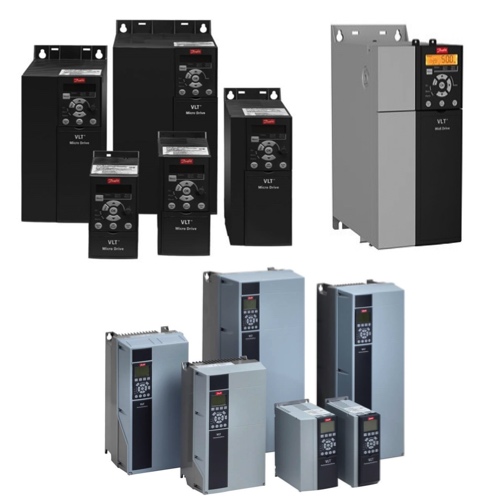Danfoss VFDs

RSP Supply carries a full line of Danfoss Variable Frequency Drives (VFDs) designed to deliver smooth, energy-efficient motor control in a wide range of industrial, commercial, and utility applications. Available in single- and three-phase configurations, Danfoss VFDs are engineered for versatility, durability, and performance, providing precise control for both asynchronous and permanent magnet motors.
The Danfoss VLT AutomationDrive is built for variable speed control on all industrial machines and production lines. Its modular, flexible design allows for plug-and-play expansion, supporting additional features such as advanced fieldbus communication, integrated positioning control, and multiple motor protection and safety functions—including STO, SLS, SMS, SSM, and SS1. Suitable for grid voltages up to 690 V, these drives are proven performers in demanding environments.
The Danfoss VLT Micro Drive FC 51 is a compact, cost-effective solution for smaller installations. Its small footprint saves panel space while its coated PCBs provide dependable operation even in challenging conditions. Guided programming and PC-based configuration tools make setup quick and simple.
For water and wastewater operations, the Danfoss VLT AQUA Drive offers specialized control for pump and fan systems. With extensive built-in features and optional performance upgrades, the AQUA Drive helps reduce energy consumption, improve system reliability, and lower maintenance costs in both new and retrofit projects.
The Danfoss VLT Midi Drive FC 280, designed as the successor to the VLT 2800, is tailored for food and beverage, material handling, and process industries. It features identical mounting dimensions and connectors to the previous model, making it a direct retrofit option. Intuitive setup tools ensure fast commissioning and seamless integration into existing panels.
Together, these VFD solutions enable complete motor management; allowing smooth starts and stops, full speed control, and optimized energy usage across the operating cycle.
Comparison: Starters, Soft Starters, and VFDs
Motor Starters
Motor starters safely start and stop motors using a contactor, overload, and circuit protection. They provide reliable basic control but allow a full-torque start, which can cause mechanical stress and high inrush current. They are cost-effective but lack variable speed control.
Soft Starters
Soft starters limit inrush current and mechanical stress by gradually ramping voltage during motor startup. They extend motor life and are smaller and less expensive than VFDs when only controlled acceleration is needed. However, they do not provide full speed control.
Variable Frequency Drives (VFDs)
VFDs offer complete speed control; start, stop, and intermediate operation. They provide energy savings, reduced wear, and comprehensive motor protection but are larger and costlier than starters or soft starters. They may also require ventilation or cooling due to heat generation.
FAQs
Q: What are the main advantages of using a Danfoss VFD?
Danfoss VFDs deliver full variable speed control, energy efficiency, and precise motor management while reducing mechanical wear and electrical stress on connected equipment.
Q: What applications are best suited for Danfoss VLT AutomationDrives?
VLT AutomationDrives are ideal for manufacturing, material handling, process automation, and HVAC systems where precise speed control and network connectivity are critical.
Q: Are Danfoss Micro Drives suitable for harsh environments?
Yes. The VLT Micro Drive FC 51 features coated PCBs and robust design elements that ensure reliable operation in dusty, humid, or high-temperature environments.
Q: What makes the VLT AQUA Drive unique?
The VLT AQUA Drive is specifically optimized for water and wastewater pumping systems, offering integrated pump control, reduced energy usage, and system monitoring functions.
Q: How does a VFD differ from a soft starter?
A soft starter only controls motor startup and shutdown, while a VFD provides continuous, variable speed control throughout operation for greater efficiency and flexibility.
Why Buy Danfoss Variable Frequency Drives (VFDs) from RSP Supply
RSP Supply offers a full selection of Danfoss VFDs, including VLT Automation, Micro, AQUA, and Midi Drive models; available with fast shipping, competitive pricing, and expert support. Whether your project involves process control, HVAC, or water systems, RSP Supply provides the products and knowledge you need to keep your operation efficient, safe, and reliable.

